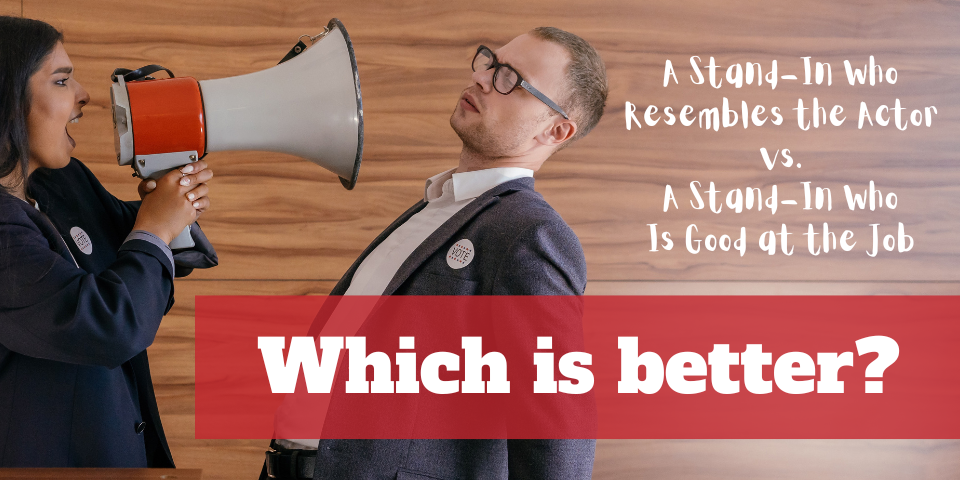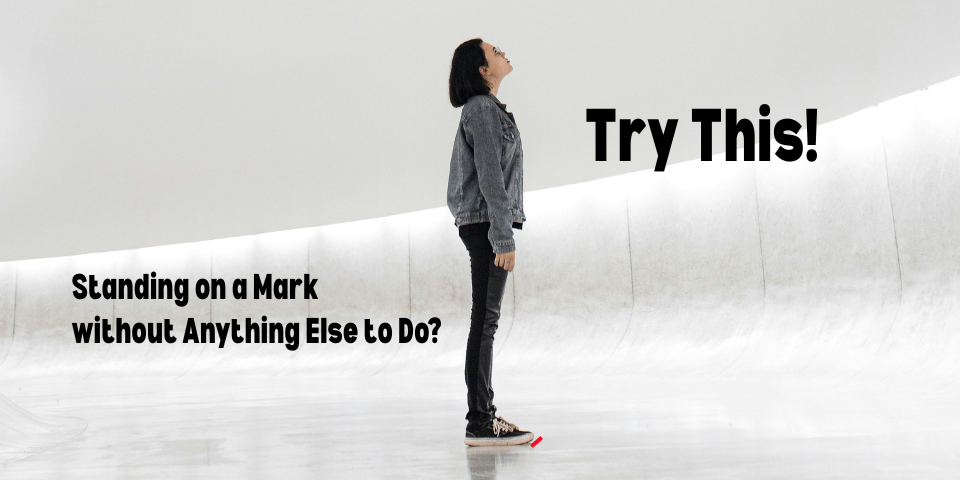There is a debate (perhaps) about the question:
Which is better?
a) a stand-in who resembles the actor
b) a stand-in who is good at the job
So, which is better? Here are some (controversial) thoughts.
On Stand-Ins Who Resemble Their Actors
When it comes to directors of photography (DPs), most take their jobs very seriously. However, not all DPs are the same, and there is a range of approaches to DP work.
Some DPs are relaxed, go with the flow, and can light a shot no matter who is standing in.
Some other DPs are also relaxed, but they might need some help from their stand-ins. Sometimes DPs need their stand-ins to be close in skin tone to the actor for whom they’re standing in, or hair color, or they need the stand-in to be wearing a similar color of clothing as the actor. Most DPs appreciate some similarity between the “aesthetics” of actors and their stand-ins, but rare are the DP demands greater than requests for similar skin tone, hair color, height, or other general physical features between actors and stand-ins.
Some other DPs may still be relaxed, but they might have some “requirements” around the stand-ins they want to use. For example, an actor may have distinctive facial features such as “deep-set eyes,” a “prominent nose,” “sharp features,” or some other feature that has a specific effect on lighting or shadowing. These DPs might seek stand-ins who have similar features as the actors, because lighting such stand-ins may make it easier for the DP to ensure the actors are lit well when the actors step in, minimizing adjustments and saving production time.
Then there are other DPs who may not be particularly relaxed and may be demanding in terms of how they want stand-ins to look. They may value the stand-in who exactly resembles an actor, with no care as to whether that stand-in actually knows how to do the job.
So, in questioning which stand-in is better — a stand-in resembling an actor or a stand-in who is good at the job — the answer may depend on how demanding the DP’s work is. If a DP must have a stand-in who resembles the actor in order to do the DP job well, then a stand-in who resembles an actor may be better than an actor who does the job of standing in well.
On Stand-Ins Who Are Good at Their Jobs
When it comes to assistant directors and production as a whole, there is a time-is-money component to work on TV and film projects. Every minute spent costs both money and crew energy.
How stand-ins fit into the time-is-money equation is that stand-ins allow a production to save time and money in setting up shots, giving crew time to rehearse and prepare a shot while actors get ready in hair, makeup, and wardrobe. Thus, by using stand-ins, productions can maximize production time for a relatively small expense on labor.
Stand-ins have a range of experience levels. Some stand-ins have worked as stand-ins in TV and film for years, and they understand not only the rhythms of set and production but also the various needs of crew members who work with stand-ins, in order to quickly serve their needs and spare their energy.
Then there are stand-ins on the other end of the spectrum, whose first day of work as a stand-in is today, and they have virtually no understanding of a set or how a TV show or film is made. These new stand-ins are at the mercy of others telling them what to do, rather than knowing what to do on their own. (A good reason these stand-ins should download The Stand-In Handbook!)
Stand-ins who are good at their job mean they can work more or less independently, with production not having to chase them down, not having to tell them what to do, and not having to teach them about the job of standing in. Assistant directors and productions with experienced stand-ins are spared the stress of “cat herding” stand-ins, and production moves along without the unpredictable chaos of stand-ins who can’t be found or don’t know what to do when on set beyond standing on one mark.
So, experienced stand-ins may be better than stand-ins who resemble actors, because experienced stand-ins may be generally more functional in terms of a production’s bottomline, as well as generally more helpful in sparing the crew energy.
“The Total Package”
Of course, in the debate of whether an “aesthetic” stand-in is better than a “functional” stand-in, the answer does not have to be either-or. Naturally, a stand-in can both be an aesthetic match for an actor as well as be an experienced stand-in. Such a stand-in might be deemed (aside from any disqualifying characteristics) “the total (stand-in) package.”
This “total package” in a stand-in may mean the stand-in not only can be relied upon to do the work, but also may be more useful for the production. For example, productions frequently enough need photo doubles for actors, and if the stand-in is a solid match for the actor, that means the production does not have to cast a wide net to find a photo double.
At that, a trusted stand-in may help a production in additional ways, such as when an actor can’t make it to a rehearsal with the cast, when a day-playing actor is knocked out of work after a positive coronavirus test, or when a new need arises. A trusted stand-in may inspire confidence in the production that the stand-in can take on the surprise additional work.
(On Disqualifying Characteristics)
Perhaps it should be said that “the total package” stand-in may be disqualified if that stand-in is demanding, hard to work with, or needlessly problematic to production.
This is not to say a total-package stand-in should not stand up to production at appropriate times or rock the boat when it needs rocking. A total-package stand-in is not a pushover. This is simply to say that being a toxic personality on set might defeat the purpose of having that aesthetically and functionally desirable stand-in on the job.
Conclusion
If you are new to standing in on TV or films, it would definitely serve you as well as production to listen, stay alert, and care about working as a stand-in. When you do, you help other stand-ins working with you, the crew around you, and the production as a whole. People will notice your interest, and such interest will generally rub off in a good way on your professional future.
If you are experienced at standing in, it may help you to land more jobs if you consider your appearance and what may help you land additional work. For example, you might consider your hair color, whether to go sunbathing the day before a job, what your actor will be wearing in tomorrow’s scenes, how your actors are wearing their hair in different scenes, etc. These little appearance considerations and adjustments can also show how much you care about the work and others’ work, and rub off on you in a good way professionally.
So what’s the answer to what’s better?
In our opinion, while it ultimately depends, we’d take a stand-in who is good at standing in almost any day over a stand-in who simply looks like an actor.
Do you agree with our take on stand-ins who resemble actors versus stand-ins who are good at their job? Post your opinions in the comments below!







Leave A Comment